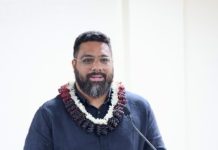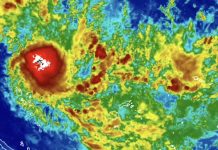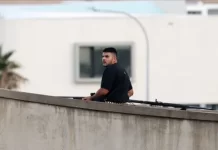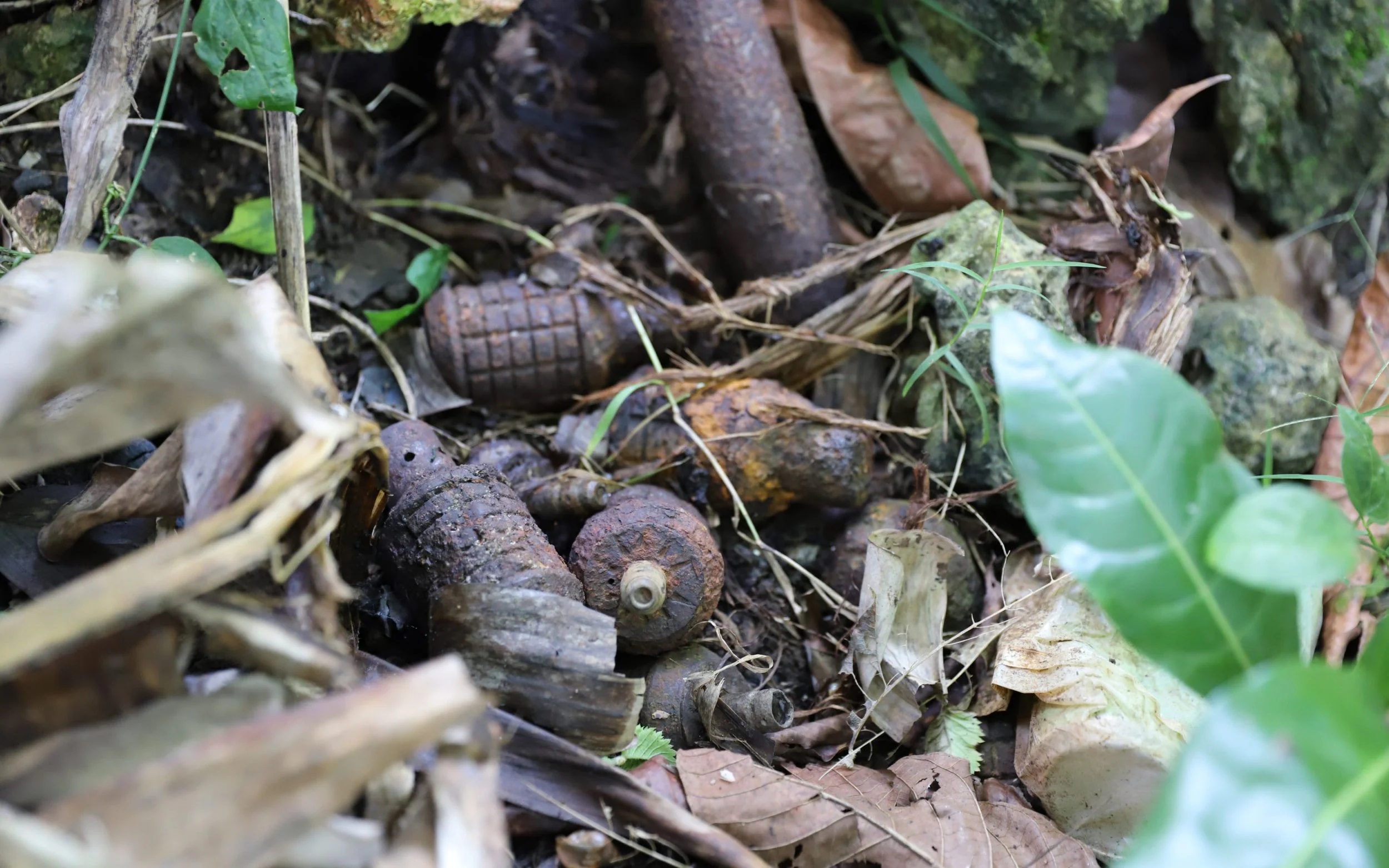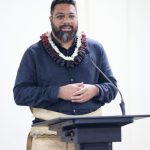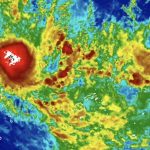Eighty years after intense battles were fought over the archipelago, Solomon Islanders are still regularly maimed and killed by ordnance
By Nicola Smith, Asia Correspondent, Charley Piringi in Honiara and Harriet Barber
The excited chatter among a gaggle of children rose as a little boy suddenly came forward, arms outstretched, hands cupped under a corroding pineapple-shaped Japanese WW2 grenade.
“I found it in the water over there and there are two more,” said Bernard, 13, tilting his head towards the polluted stream running through Mbokona, an expanding shantytown in Honiara, the capital of the Solomon Islands.
In a heartstopping second, a nearby adult delicately picked the live munition from the child’s hands and placed it carefully on the grassy verge next to the potholed gravel road.
The bomb squad was called, but at a safer distance the children milled around non-plussed, laughing and jostling each other. “We find bullets and grenades all the time, especially when it rains heavily,” said one of Bernard’s playmates.
“Munition is lying all around. We tell the children not to touch it but when they see these things, they start playing with them,” said John Mole, a local father who recently moved into the area. “It’s frightening to live here.”
The incident occurred as the Telegraph was researching the problem of abandoned munitions in the Solomon Islands, but the child’s discovery was sadly not unusual.
Eighty years after intense battles were fought over the remote archipelago that proved a pivotal theatre in the Allied campaign to stop Japan’s advance in the South Pacific, Solomon Islanders are still regularly maimed and killed by ordnance discarded by US and Japanese forces when they died or withdrew.
The deadly remnants of war – unexploded munitions known as UXO, rusting airplanes, tanks, and warships in danger of leaking oil on the seabed – stretch from Guadalcanal island westward to the border with Papua New Guinea, blighting the daily lives of the 700,000-strong population.
Experts believe hundreds of thousands of potentially lethal unexploded items may remain beneath major population areas, including Honiara, where some of the fiercest air, sea and land combat took place between thousands of US and Japanese troops in the Battle of Guadalcanal from 1942 to 1943.
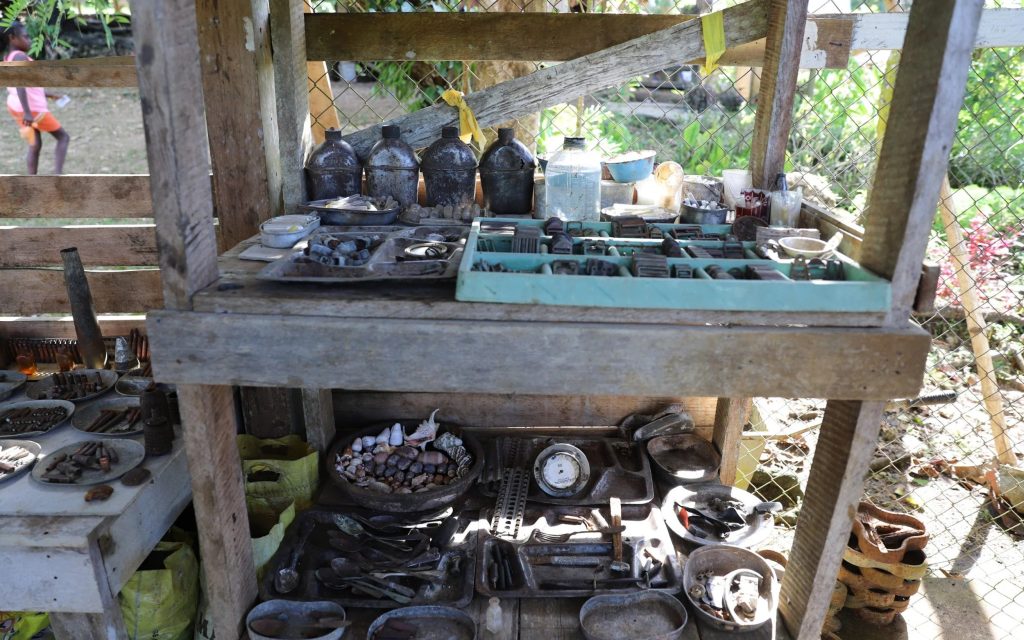
Terrible gamble
The Solomon Islands is an archipelago of six major islands and over 900 islands, spread over 11,000 square miles northwest of Vanuatu.
For decades, the deadly ground has stymied economic development in the impoverished nation, making simple tasks like house-building and construction life-risking ventures. Farmers are afraid to till their land and the common agricultural practice of slash and burn has become slash, burn and run.
Even gravediggers face a terrible gamble when burying the dead and families are wary of cooking over open fires. In 2021, a Honiara man found 101 unexploded WW2 shells while digging a new septic tank in his garden.
Before work began on the site of a flashy Pacific Games stadium next to the international airport – once Henderson military airfield – over 8,000 projectiles, grenades and cannon rounds were dug out of the ground.
Clearance campaigns and the funding of them has been sporadic over the years. The Explosive Ordnance Disposal (EOD) team of the Royal Solomon Islands Police Force is highly skilled but the 14-man squad is overstretched and can only respond to emergency calls rather than preemptively sweep the land.
Some reports point to more than 20 killed a year by discarded ordnance but the lack of historical records of casualties and bomb discoveries has also crippled widescale clean-up efforts. The most consistent data was kept between 2011 and 2022 when 42,000 call outs were made to the police.
A new state department-funded survey by the Halo Trust, a British charity, now hopes to turn the tide on the dire situation by mapping out the worst impacted areas and prioritising them for clearance operations.
Simon Conway, head of programme development, who since 1998 has worked on munitions survey across Asia, Africa and the Middle East, said he had been taken aback by the extent of the contamination since he arrived in the Solomons last August.
“I had been working all over the world for about 25 years but didn’t really have a sense of the scale of the problem and it was only when I came here that I realised quite how significant it is and quite how it affects almost every element of living here,” he said.
“I was shocked by the amount of time that had gone by. Here you are 80 years later and people have literally got stuff in their gardens that is dangerous.”
Conway and his small local team hope to begin an extensive survey of the Solomons six main islands in May, using WW2 records from the National Archives in Washington DC as well as tapping into local knowledge.
Their task is to pinpoint the most intense patches of contamination and categorise them into polygon-shaped areas, prioritising them in terms of density of ordnance and human activity on the land.
The team also plans to map out water catchment areas at risk of chemicals such as white phosphorous from corroding Japanese munitions and to build a database of historic accidents to identify those most vulnerable to injury.
“The very things that were fought over are now what people are living on top of which is a big part of the problem,” said Conway. “What is clear is that there is going to need to be a really large-scale clearance.”
The risk is set to grow as the demand for housing in the coastal capital of 80,000 pushes homes and shanties out further to the surrounding ridges and slopes that were once the scene of heavy aerial and naval bombardment, and ground artillery fire.
Places exactly like Mbokona where a chain small wooden huts have now sprouted through the lush vegetation lining a ravine where some 700 Japanese soldiers made their last stand.
They died loaded with ammunition like the type 91 grenade found by Bernard.
Soldiers would tap the grenade on their helmets to activate the fuse and throw it at the enemy. The outer casing was designed to increase fragmentation and the passage of time has made the device no less precarious, particularly in the hands of playful children.
“Curious young boys are the most ‘at risk’ group,” said Conway. “They do need risk education as a priority.”
But while some munitions are easy to spot, islanders know they can never escape the danger of what may lie beneath the ground’s surface, even during the most mundane daily activities.
Doreen Noda, 62, saw her youngest son Charles, 38, mortally wounded at a church BBQ on Mother’s Day in 2021.
He and his friend Raziv Hilly had been cooking cabbage over a firepit since early morning and by mid-afternoon the heat seeping into the soil triggered an unexploded 105mm US projectile buried some 20cm deep.
Noda was one of dozens of people who, in a miraculous twist, had retreated a few minutes earlier from the garden to the host’s home due to a heavy downpour.
After the blast, she was the first to run to his aid.
“The bomb went off and I shouted “Oh! My son is dead!” and we ran down the slope to where they were cooking,” she said.
“I saw both of them laying there in the same direction. [Charles’] leg had been ripped open and he was staring up. The other one, both of his legs were gone. He was crying. It was a terrible shock and I shouted for help,” she said.
Raziv, a civil engineer, bore the brunt of the blast and died shortly afterwards, while Charles passed away a few days later in hospital.
He had been a successful accountant and auditor who studied in the UK on the prestigious Chevening scholarship and his death was devastating for his family and the wider community.
Noda lost not only her son, but also her happy home life with his four young children, who left shortly afterwards to return to his wife’s home province of Malaita.
She gestured sadly at the home where they all once lived. “As a mother, it’s very painful,” she said, adding that her own future was now uncertain. As she spoke, her sister Margaret sobbed in the background.
The tragedy occurred next to a mango tree at a house in an upmarket residential suburb overlooking central Honiara, near the New Zealand and Chinese embassy residences.
Calvin Sese, survey team leader with the Halo Trust, who has been using historical records to meticulously map out former battle lines in the city, said during WW2 the spot was codenamed “Hill 84” by U.S Marines as they advanced towards it.
The area came under heavy bombardment when they were pinned down by Japanese forces and called for naval support. “This area up here is one of the most contaminated in Honiara but nobody knows about it,” he said.
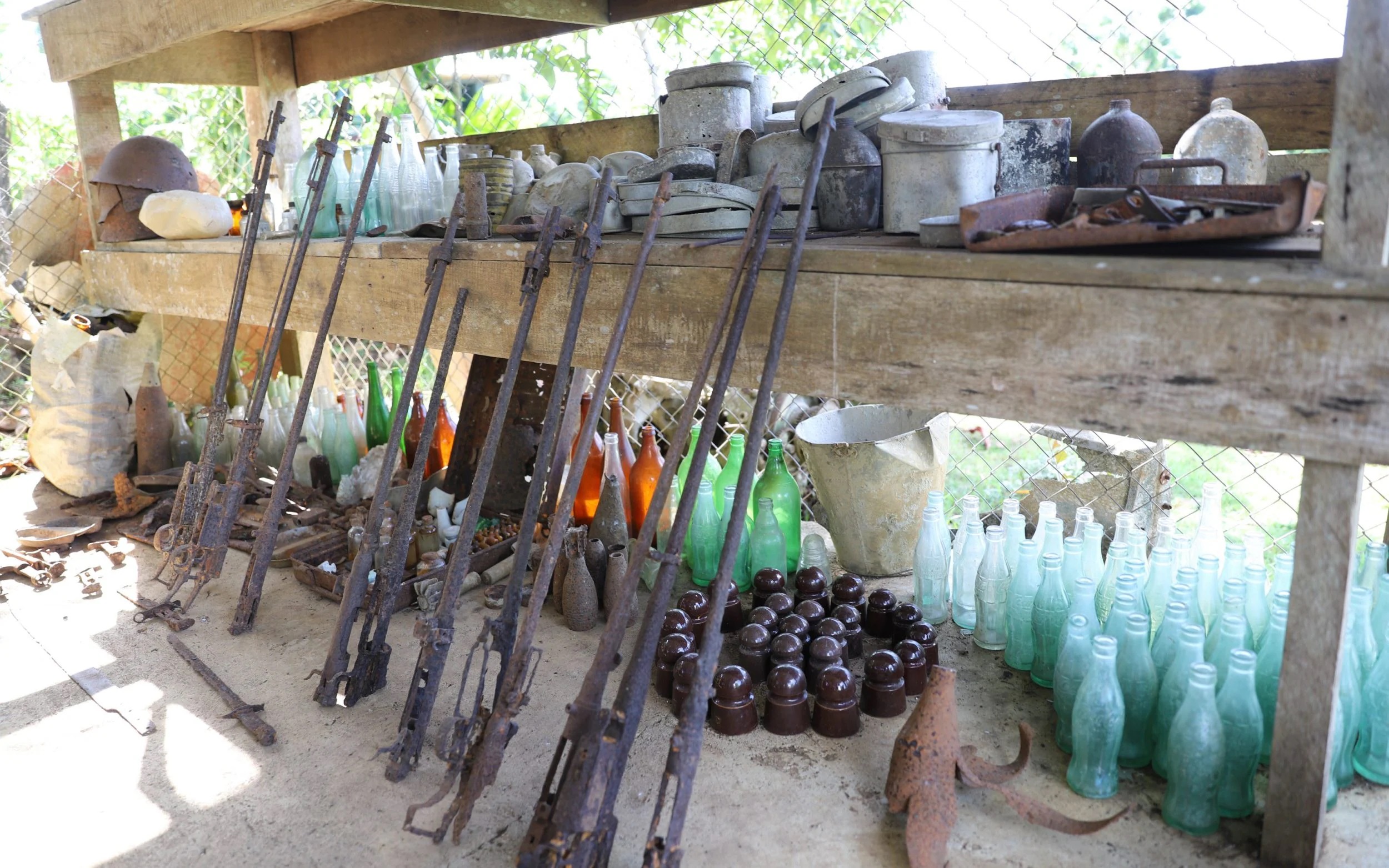
The growing significance of the Solomon Islands in the tussle between the United States and China for dominance in the Pacific has thrown a new spotlight on the WW2 munitions problem.
“The whole reason the Pacific was being fought over was the strategic leap between Australia, the US and Japan and then they forgot about it because the war ended,” said John Rodsted from Australian nonprofit SafeGround, who has advocated for bomb clearance in the Solomons for years.
“That strategic situation is back again because of China. It’s got the same strategic importance as what it had back then.”
Roughly 80 percent of the ordnance is estimated to have been left by the U.S and 17 percent by Japan. Since 2011, the US has provided more than US$6.8 million to support the police in identifying and destroying explosive remnants of war, according to the State Department.
“This terrible legacy of the past holds the future hostage in far too many ways,” said Russell Comeau, U.S Chargé d’Affaires, in a speech this month.
“Much work remains in scrubbing the land of this terrible legacy of WWII. And I want to reiterate, that this is work my government is committed to undertaking as we all seek to reduce this persistent threat.”
Help can’t come quickly enough for Solomon Islanders.
New homes are now creeping up the gentle slopes of Mount Austen, on the perimeter of the city, a former Japanese stronghold which offers stunning ocean vistas towards the island of Tulagi, and Savo, a simmering volcano.
It’s a stretch of water known as “Iron Bottom Sound” because of the dozens of WW2 warships that sank there. Mount Austen and the surrounding area was pummelled by constant naval shelling and aerial bombing raids.
The tiny village of Barana, 20-minutes-drive up the hill from central Honiara, was founded in 1965 but its inhabitants still live under the shadow of UXO, sweeping the ground with metal detectors any time they wish to build.
The village has a makeshift museum of dog tags and decommissioned munitions, and sacks of Japanese human remains, which are collected by the embassy.
But it is still plagued by live bombs. On the village periphery, some 30m from a home with a breastfeeding mother, is a stash of rusting hand grenades that the residents dare not move.
Jimmy Besi, 55, a village elder, said live ammunition often turned up in people’s gardens, recounting a huge explosion in his neighbour’s yard a few months ago when he lit a fire.
It had terrified the community, he said. “We tell the children about the bombs – don’t touch and don’t play with them and if we find something in our village, we must put it aside.”
The village longed for some support to clear their land, he said, echoing many others who want to live without fear.
“There is a simple equation which is money equals time equals lives. The more money that hits the ground quickly, the faster this can be cleared up and the less people are going to die,” said Rodsted.
“The longer this stuff lies around the more lives are going to be lost.”
SOURCE: THE TELEGRAPH UK/PACNEWS


